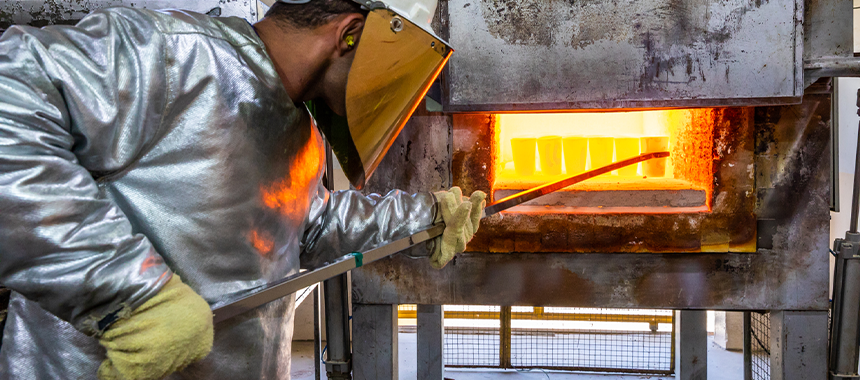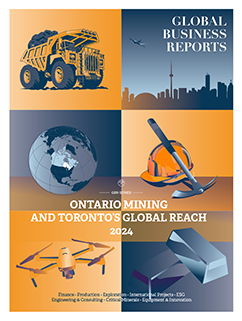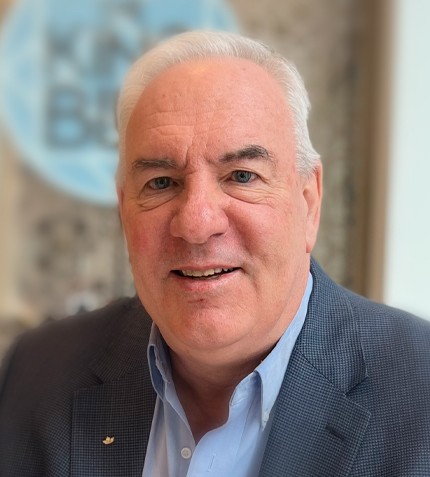Ontario’s Mining Production: Digging into the province’s riches
RELATED PUBLICATION
ARTICLES FROM THIS PUBLICATION
Ontario’s Mining Production

Image courtesy of Equinox Gold
Ontario managed to maintain its status as a top mineral producer, generating C$13.5 billion worth of minerals in 2022 – representing 22% of Canada’s total mineral production value. In 2022, the Ontario Mining Association (OMA) reported that Ontario expects C$13.7 billion worth of mineral production in 2025. Should the current levels of growth continue, that forecast may be reached sooner than anticipated.
The passing of the Building More Mines Act is expected to make it easier for companies to get a permit to recover minerals from mine tailings and waste, allow more flexibility in the techniques used to rehabilitate closed mines, and improve closure planning by having more qualified professionals available, among other things.
The Act and the MoU between Ontario and Nevada are just some of the major developments of 2023. However, it is not just government officials that have been busy; industry players have been raising capital, expanding mines and staking new claims. The exceptional Canadian mining M&A activity seen in 2021/2022 continued into early 2023, with Agnico Eagle announcing the completion of its acquisition of Yamana Gold’s Canadian assets, including Yamana’s properties in Ontario.
Mergers & acquisitions
Despite having slowed down towards the end of 2023, consolidation may continue to be an attractive prospect for some players in 2024, as resources can be pooled together to weather market challenges. “Financial and human capital is scarce. Companies are consolidating to strengthen their management teams, secure funding, and explore synergies between complementary projects,” said Alexander Pizale, partner, Cassels Brock & Blackwell LLP.
As market volatility continues to make investors more risk-averse, mining companies will need to have a clear, defined set of projects and a clear focus to attract investment. M&As can also help on this front: “There are many pressures on the industry that could cause people to reevaluate a company’s plans, and consider combining projects with those of other companies, or moving certain projects into different or new companies so as to promote a more coherent plan,” said Denis Frawley, partner, Ormston List Frawley LLP.
Always looking to extract the most value from M&As, some of Ontario’s companies have taken a different approach: “We are seeing more ‘syndicated acquisitions’, being acquisitions where multiple companies approach an acquisition jointly and find creative ways to extract value from the transaction. For example, one company may acquire one specific asset, while the rest of the package is divided between other companies, according to their needs,” shared Ian Mitchell, partner, head of mining, Gowling WLG.
Mitchell observed that this practice appears to have trickled down from the big players, and is now being increasingly observed in mid-market.
Gold production
Gold continues to be the backbone of Ontario’s mineral production, with 21 out of the 41 operating mines in Ontario being gold mines. Ontario’s annual gold production in 2022 amounted to 121,304 kg, an almost 22% increase from 2021, maintaining its position as Canada’s top gold-producing province. The strong gold price and increased production levels have resulted in a good year for Ontario’s gold producers. This comes as Ontario’s miners are busy exploring northern Ontario for new deposits and spending billions of dollars expanding their existing mines.
Ontario’s Minister of Mines George Pirie recently commissioned shaft #4 at Agnico Eagle’s Macassa mine, the 9th largest gold mine in Canada, and listed other ongoing developments, during his interview with GBR: “Agnico’s Detour Lake mine has a huge expansion program, McEwen Mining is expanding its Black Fox gold mine, and Alamos Gold has also been expanding its Island Gold mine underground. Finally, Newmont is getting ready to re-develop its old open pit Porcupine mine,” Pirie explained.
In March 2023 Agnico Eagle acquired the remaining half of Canadian Malartic, thus consolidating two major gold-producing assets in the Abitibi belt – Detour Lake and Canadian Malartic’s Odyssey mine. This comes in addition to Agnico’s acquisition of the Upper Beaver deposit a few kilometers away from Macassa. Agnico Eagle is very bullish on the prospects of the Abiti belt across Ontario and Québec. "We continue to look for synergies and opportunities in the Abitibi region, including the opportunity to process Upper Beaver and AK ore in our processing facilities in Québec," said Andre Leite, vice president – Ontario operations, Agnico Eagle.
Alamos Gold’s phase 3+ expansion at the Island Gold mine is due to be completed in 2026. Alamos' president and CEO John McCluskey takes a long-term view: “The earthworks associated with these types of tailings expansions have been responsible for problems in previous Ontario project developments, so we decided that the best way to de-risk the whole project was to focus on that first. We ensured this was underway before we announced phase 3+ of the study.”
Alamos Gold performed well in 2023, having increased its 2023 guidance with record annual production guidance by 5%. “The success we are enjoying today is a product of a strategy that we have pursued for 10 years based on accretive acquisitions and investment in organic growth through exploration, expansion and development of our various projects,” said McCluskey.
Argonaut Gold’s past-producing Magino mine achieved commercial production on November 1st 2023. Despite the slower-than-planned ramp-up of Magino, the mine is still expected to become Argonaut Gold's largest and lowest-cost mine. Argonaut Gold’s president and CEO, Richard Young, shared the next steps for the mine: “As we look towards 2024, Magino remains a focal point, with plans to complete the current infill drill program and finalize a comprehensive feasibility study for the project. This study will outline the path forward, potentially including mill expansion and increased production.”
Like many mine operators in the province, Argonaut had to grapple with the scarcity of labor plaguing Ontario. Although the company has overcome these hurdles, they were likely a contributor to the delay in Magino’s first gold pour. “A notable challenge we encountered was recruiting personnel, particularly in Ontario. The scarcity of qualified individuals has posed difficulties, significantly impacting the ramp-up process both in the mine and the mill at Magino,” continued Young.
In Ontario’s far west, Australian producer Evolution Mining spent FY2023 commissioning the underground Upper Campbell mine in the Red Lake complex. Acquired in 2020 from Newmont, Evolution hopes to eventually ramp up production to 1.1 million t/y and restore Red Lake to a premier Canadian gold mine. Evolution brings the expertise it gained operating four producing mines in Australia to its new Canadian asset. “Australia is very good at bulk mining and achieving high productivity levels. These are things we are trying to embed into our Red Lake operations. It is much easier to make money when your mine has 30-50+ g/t Au (previously at Red Lake), where you can go underground and easily see the gold. When you drop down to 5-7 g/t, as we are, productivity becomes much more important,” said Lawrie Conway, managing director and CEO, Evolution Mining.
Rising costs
As the gold spot price climbs to new highs over US$2,000/oz, all eyes will be on Ontario’s miners to see if they can capitalize on the current bull run. However, despite the all-time high gold prices, gold miners are trading well below their 2011 record highs.
Many producers reported a sharp increase in the cost of mining in recent years. Whether it is energy, raw materials, machinery, wages, permitting, exploration costs, etc. – most cost factors have increased. “Inflation rates around the world have accelerated in the last two years, which has put pressure on the cost of inputs,” shared Conway.
The labor crunch has forced many mine owners to increasingly rely on contractors, further pushing up costs. “We have witnessed a significant rise in cost inputs, particularly in labor, which typically constitutes over 50% of our revenue. Additionally, raw material costs have increased, although there is a recent tapering off from the high rates observed post-Covid,” shared Eric Smith, managing director at Cementation Americas, a large underground mine contracting and engineering company.
With a tense geopolitical situation and global government debt poised to hit a 40% increase since 2019 levels, the price of gold may climb even higher, perhaps offsetting the high cost of mining. “Unlike traditional commodities like oil and copper, every ounce of gold mined throughout history is essentially available as above-ground supply. What determines the gold price is its relative value to financial assets like stocks, bonds and fiat currencies. We believe the price of gold is poised to go significantly higher over the next several years due to an upcoming global sovereign debt crisis,” said Rudi Fronk, chairman and CEO, Seabridge Gold.
These challenges are not exclusive to Ontario’s miners, the problem appears to be impacting many gold producers worldwide. The $GDX, a popular exchange-traded fund that tracks the performance of over 50 major gold mining companies globally, has failed to keep up with the performance of gold recently, with 5-year returns of under 20% while gold prices have increased over 50% in the same period. Dwindling reserves, ill-timed acquisitions, and declining mine grades are perhaps some other factors contributing to this underperformance.
The increasing cost of mining is, on its own, a problem. However, the uncertainty that accompanies it complicates matters even more. “Despite recent signs of moderation, the persistence of inflation has resulted in cost escalations on mining projects. With project studies experiencing significant inflationary pressures, it has made it even harder for producing companies to attract investors,” said Shaun Usmar, founder and CEO, Triple Flag Precious Metals Corp.
As cost increases continue to bite, the industry may be forced to change course, instead working on smaller, more affordable projects. "The industry's focus has moved from billion-dollar mega projects to smaller endeavors ranging from C$300-600 million, offering less risk, quicker paybacks, and higher returns. This change, emphasizing rate of return and capital expenditure over net present value, is particularly notable among emerging producers and mid-tier companies,” said Eugene Puritch, president and principal mining engineer, P&E Mining Consultants.












